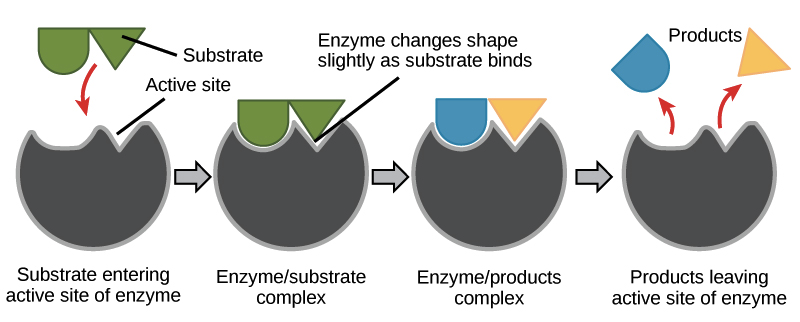
Thermolabile protein part of enzyme is?
A.Apoenzyme
B.Proenzyme
C.Holoenzyme
D.Isoenzyme
Answer
515.7k+ views
Hint: Enzymes are biological molecules (typically proteins) that significantly speed up the rate of virtually all of the chemical reactions that take place within cells. They are indispensable forever and serve a wide scope of significant capacities in the body, for example, helping in absorption and digestion.
Complete answer:
Some enzymes help break large molecules into smaller pieces that are more easily absorbed by the body. Other enzymes help bind two molecules together to produce a new molecule Different compounds help tie two atoms together to create another particle. Proteins are profoundly particular impetuses, implying that every compound just accelerates a particular response to the atoms that a catalyst works with are called substrates.
The substrates tie to a locale on the catalyst called the dynamic site. Two hypotheses are clarifying the compound substrate collaboration. In the lock-and-key model, the dynamic site of a catalyst is correctly formed to hold explicit substrates. In the actuated fit model, the dynamic site and substrate don't fit entirely together; rather, the two of them modify their shape to an interface.
Whatever the case, the responses that happen quicken significantly — over a million-fold — when the substrates tie to the dynamic site of the protein. The compound responses bring about another item or particle that at that point isolates from the chemical, which proceeds to catalyze different responses.

Hence the correct answer is OPTION(A)
Note: When the point when the protein part of the form protein or holoenzyme. It is composed of amino acids. It participates in the reactant movement of the protein. It is heat touchy. It works just at the ideal temperature. It gets latent at high temperature or low temperature.
Complete answer:
Some enzymes help break large molecules into smaller pieces that are more easily absorbed by the body. Other enzymes help bind two molecules together to produce a new molecule Different compounds help tie two atoms together to create another particle. Proteins are profoundly particular impetuses, implying that every compound just accelerates a particular response to the atoms that a catalyst works with are called substrates.
The substrates tie to a locale on the catalyst called the dynamic site. Two hypotheses are clarifying the compound substrate collaboration. In the lock-and-key model, the dynamic site of a catalyst is correctly formed to hold explicit substrates. In the actuated fit model, the dynamic site and substrate don't fit entirely together; rather, the two of them modify their shape to an interface.
Whatever the case, the responses that happen quicken significantly — over a million-fold — when the substrates tie to the dynamic site of the protein. The compound responses bring about another item or particle that at that point isolates from the chemical, which proceeds to catalyze different responses.

Hence the correct answer is OPTION(A)
Note: When the point when the protein part of the form protein or holoenzyme. It is composed of amino acids. It participates in the reactant movement of the protein. It is heat touchy. It works just at the ideal temperature. It gets latent at high temperature or low temperature.
Recently Updated Pages
Important Questions Class 10 English First Flight Chapter 5

Important Questions Class 9 Hindi Sanchayan Chapter 3

Important Questions Class 12 English Vistas

Important Questions Class 12 English Flamingo Chapter 3 Poem

Important Questions Class 12 English Vistas Chapter 5

Class 7 Worksheets

Trending doubts
1 ton equals to A 100 kg B 1000 kg C 10 kg D 10000 class 11 physics CBSE

Difference Between Prokaryotic Cells and Eukaryotic Cells

One Metric ton is equal to kg A 10000 B 1000 C 100 class 11 physics CBSE

1 Quintal is equal to a 110 kg b 10 kg c 100kg d 1000 class 11 physics CBSE

Proton was discovered by A Thomson B Rutherford C Chadwick class 11 chemistry CBSE

Draw a diagram of nephron and explain its structur class 11 biology CBSE




